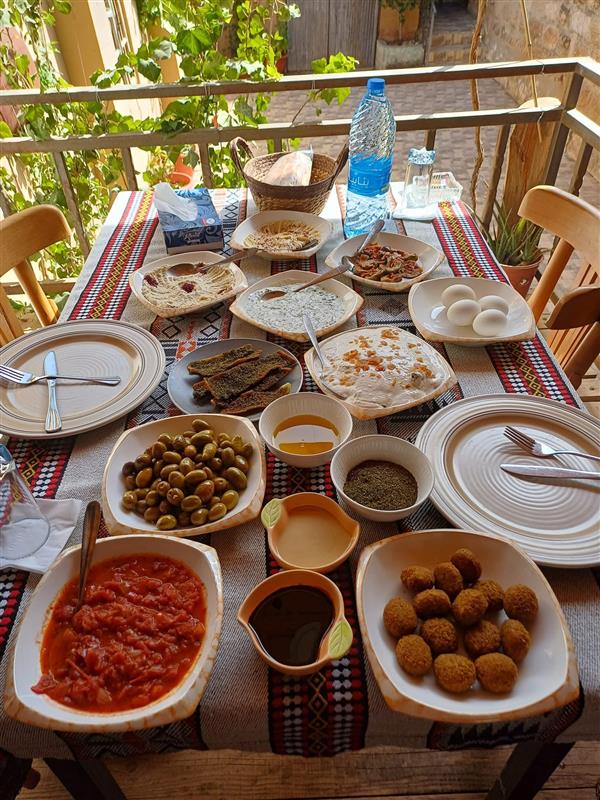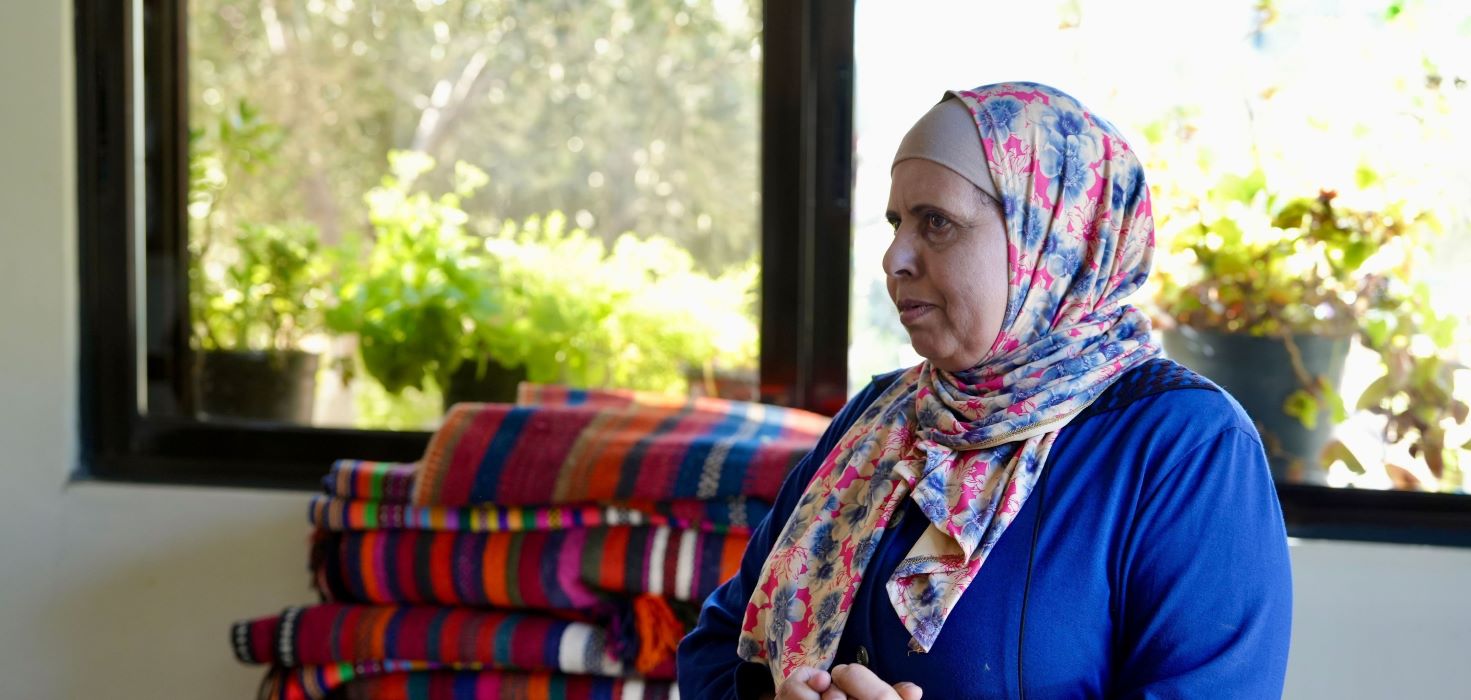Jordan, due to its geographical location in the Levant, has culinary influences from North Africa, the Middle East, Persia, and the Mediterranean.
Street food and home-cooked meals are the heart of Jordan’s Levantine cuisine. Jordanians proudly serve their rich, robust food with warm hospitality. Local cuisine has been influenced by neighboring countries like Armenia, Iraq, Syria and Lebanon. Thousands of years of history and culture blend together flawlessly to create the modern dining experience you will find in Jordan today.
Roast lamb with tart yogurt sauce called mansaf, syrupy pastries like knafeh and balava and endless sweet tea with mint and strong cardamom and arabic coffee: a trip to Jordan is a culinary experience that will leave you wanting more. The flavorful Jordanian cuisine is handcrafted with the freshest herbs, spices, and olive oil (Jordan is one of the largest producers of olives in the region), which are procured from these very markets.
Mezze is an experience in itself. It’s usually an appetizer, consisting of small shared tasting plates of dips, salads, roasted vegetables, falafel, hummus and olives with bread (pita) used for dipping and scooping. It’s a community style of eating and there is plenty to go around, so much so that it’s difficult to face the main course when it appears.
It’s all about food sharing and brotherhood.
List of the Best Jordanian Drinks and Food You Should Try in Jordan
1. Drinks
- Tea – is the Jordanian drink of choice and has a very social aspect. Instead of asking “how are you” Jordanians ask “would you like some tea?” The teas vary from black to herbal served with combinations of herbs (sage, thyme, mint rosemary or verbena), mint tea seems to be the favorite.
- Arabic Coffee – is made with ground fire-roasted beans and cardamom – not just a drink – in Jordan it’s a traditional sign of respect, a way to bring people together.
- Turkish-style Coffee – is stronger than Arabic, actually ‘high octane’. The coffee grounds, cardamom and sugar are added to a tiny pot of boiling water as it continues to boil – It’s served thick and sweet and available at street vendors all over Jordan.
- Lemon-mint Juice – is a common drink in Jordan, made from lime juice and ground mint. A sugar syrup is served on the side so you can control the sweetness.
2. Snacks
- Manakish – is a flatbread topped with thyme, olive oil and za’atar, cheese or ground meat (like a pizza) and can be sliced or folded. It’s usually served at breakfast or lunch.
- Arayes – are grilled or baked pita bread sandwiches, stuffed with minced meat. They’re crispy and really deliciously popular.
- Chicken Shawarma (sometimes made with lamb or beef) Shawarma is also popular in Europe and now North America; its thin layers of meat stacked on a sword like spit that revolves over a heat source. When cooked it’s shaved off and wrapped in bread with a garlic sauce or tahini and pickled vegetables.
- Falafel (Sandwich) – is a combination of ground chickpeas, mixed with a variety of spices, then deep fried into mini patty like shapes, is one of the most common street food snacks or light meals in Jordan. They can be eaten on their own like veggie nuggets, eaten with bread, or stuffed into sandwiches.
3. Dips
- Hummus – hummus is possibly the most well known Levantine and Middle Eastern food around the world. The hummus in Jordan is fantastic and it’s amazing how each restaurant version tasted just slightly different – the amount of lemon juice, and ratio of garbanzo beans to tahini, the texture, and also, very importantly, the olive oil. You need to try Fattet hummus!
- Foul – while ful medames might be originally from Egypt, this dish of mashed fava beans and olive oil, is also widely available and commonly eaten throughout Jordan. You’ll find ful at most restaurants that serve hummus and falafel.
- Mutabal – roasted eggplant dip with yoghurt, tahini, garlic and lemon juice.It is similar to baba ganoush, but quite different. One of the main ingredient differences is that moutabel uses yoghurt in its recipe. When it’s roasted over fire, to give it a wonderfully smoky taste and a smooth and creamy consistency.
4. Dishes
- Dolma – is a stuffed vegetable (tomato, pepper, onion, zucchini, eggplant) or leaf. The most common dolma is made from grape leaf stuffed with meat. Meat dolmas are usually served warm or hot, often with sauce; vegetarian dolmas are typically served cold.
- Makdous – usually made in the fall and stored for use over the winter. Baby eggplants get Stuffed with walnut and sun-dried red pepper, garlic, oil and salt, then preserved in olive oil.
- Mansaf – Jordan’s “national dish”, this magnificent Bedouin dish is served on big occasions like festivals or family reunions. It consists of simmered lamb (or beef) and onions mixed with yoghurt served on top of rice piled on top of buttered flatbread. The whole dish is topped with butter, almonds and pine nuts. It comes to the communal table on a large tray.
- Makloubeh – Maqluba means ‘upside-down’ which is how this dish is served. It’s a chicken dish (sometimes called upside-down chicken) cooked with rice and fried vegetables; when it’s ready to serve it’s flipped upside-down.
- Zarb – is a Bedouin barbecue consisting of lamb and vegetables; a traditional Bedouin way of cooking. A 3-tiered container (meat on the bottom shelf, veg on the others) is topped with a lid, placed in a pit, covered with hot coals then buried in the sand. After many hours the 3-tiered racks are dug up and the meal is served at sunset.
- Lamb – Jordanian food contains lots of meat, especially lamb. Popular across the Middle East and the Levantine, shish kebabs in Jordan are typically made from minced lamb, which is mixed with parsley and lots of salt, then molded onto big sword like skewers, and grilled over hot charcoal.
5. Salads
- Tabbouleh – has become one of the most popular salads in the Middle East. It’s traditionally made of tomatoes, lots of fresh finely chopped herbs (parsley & mint) bulgur, onion and a dressing of olive oil, lemon juice and salt; sometimes garlic or lettuce and couscous instead of bulgur.
- Fattoush – is a wonderful Arabic salad made of chopped vegetables (tomatoes, cucumber, radish) and crisply toasted pita chips dressed with olive oil, lemon and sumac
6. Bread
- Kubz (pita) – is referred to as “ordinary” bread. This pocket bread is served an almost every meal
- Shrak – is a Bedouin flatbread, baked on a large domed metal griddle (like an inverted wok).It can be tossed until very thin then thrown on the griddle.
7. Desserts
- Knafeh – is a rich, creamy dessert made with a cheese pastry soaked in sweet sugar-based syrup.
- Halava – often served as a side at breakfast this sweet treat is made of honey or sugar-sweetened tahini sesame paste; sometimes flavored with pistachios, almonds or chocolate.
- Baklava – a baklava is made of filo pastry with layers filled with nuts, such as pistachios, and sugar or honey syrup.
8. Cheeses
- Halloumi – is similar to feta but not quite as dry and salty – a semi-soft white cheese often served in salads
- Nablusi – one of a number of Palestinian white brined cheeses made in the Middle East. Its name refers to its place of origin, Nablus and it is well known throughout the West Bank and surrounding regions. Nabulsi, along with Akkawi cheese are the principal cheeses consumed in Jordan. Produced primarily from sheep milk, goat’s milk is also used.
- Akkawi Cheese – made with cow’s milk, but can also be made with goat or sheep milk. This cheese is largely produced in the Middle East but also in Cyprus. In these regions, people usually eat it with a soft flatbread during lunch and dinner. Akkawi is hand-packed into square draining hoops and then cured in a salted whey brine for two days.
- Labneh – is a strained yogurt cheese shaped in small balls and preserved in oil. It’s often eaten for breakfast; served with *za’atar and olive oil and spread on warm flatbread. This is a serious addiction.


